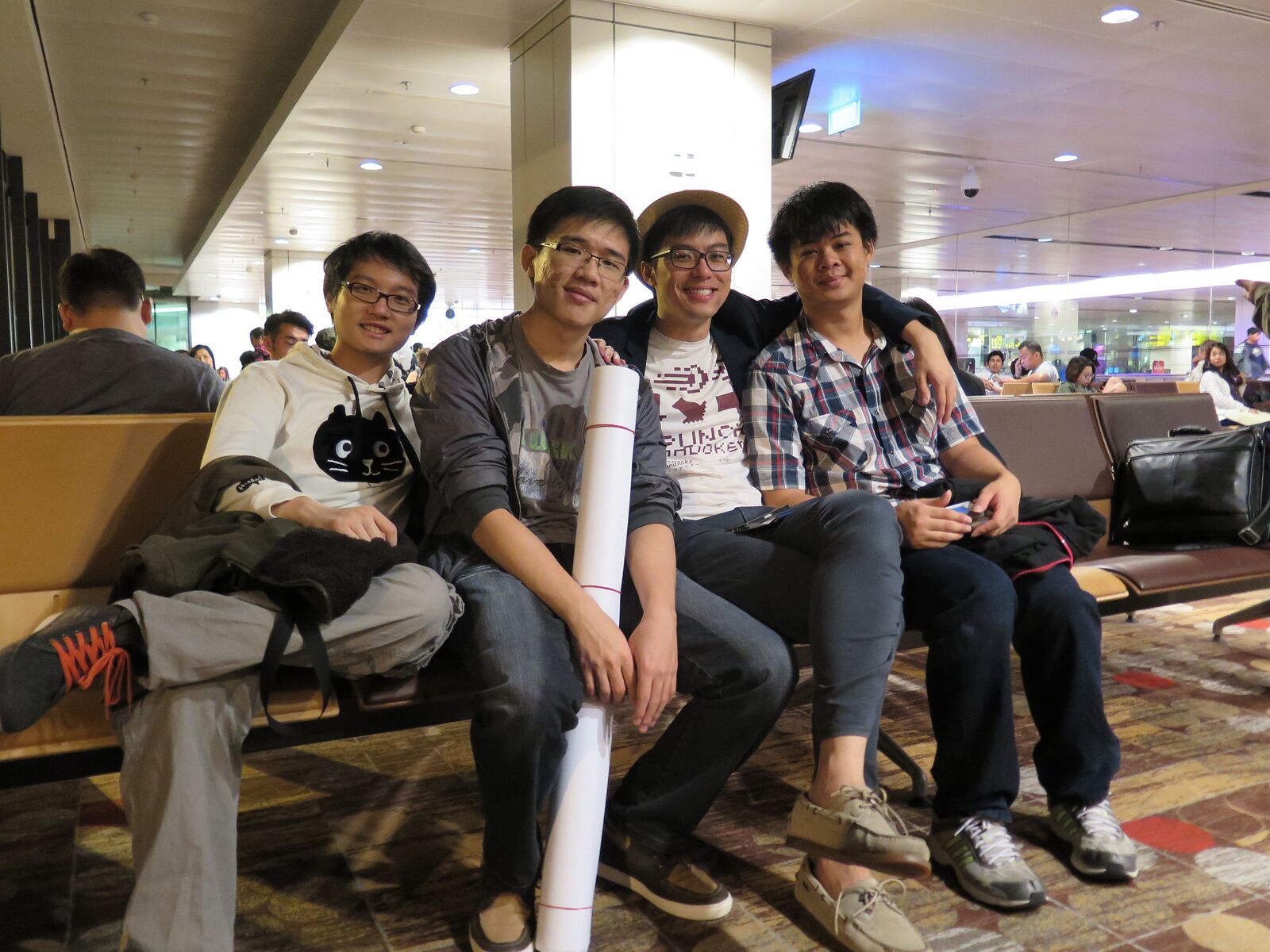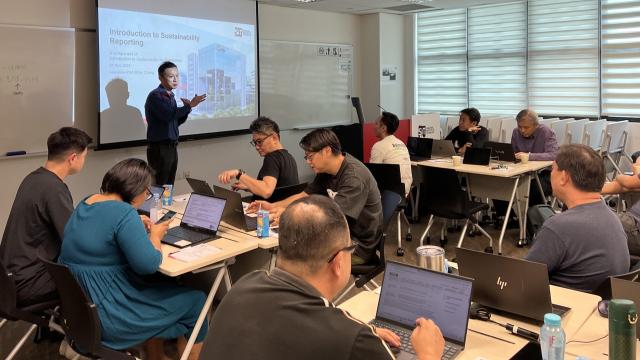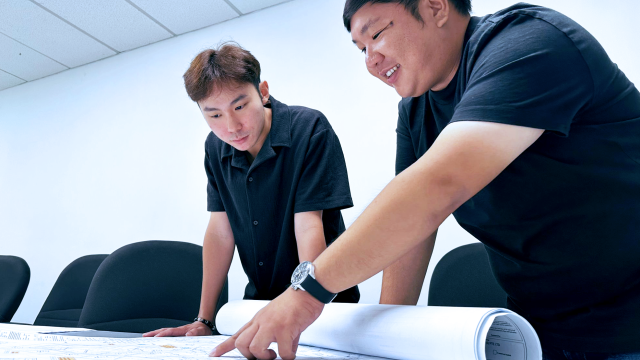Sound-based survival thriller game, ‘Lurking’, is proof that SIT-DigiPen Institute of Technology graduates are able to carve a name for themselves on the international stage.

The team who created Lurking - (L-R) Bryan Teo An Ping, Dexter Chng Shi Rong, Justin Ng, and Soo Zhong Min.
One of more recent success stories to emerge from SIT is ‘Lurking’, a sound-based survival thriller game designed by DigiPen Institute of Technology Singapore graduates. Since its launch, ‘Lurking’ has picked up a slew of awards, including the Best Student Game and Excellent Student awards at the Independent Games Festival China 2014. We chat with producer and co-creator of the game, Justin Ng, graduate of the Bachelor of Arts in Game Design programme and one of the founders of Gattai Games to find out more.
1) Tell us what you are currently doing.
I’m currently the Design and Business Guy at Gattai Games, an indie game studio made up of six DigiPen (Singapore) graduates. We’re currently working on ‘Stifled’, a spiritual successor to ‘Lurking’.
2) Tell us more about ‘Lurking’. What’s special about it?
‘Lurking’ is a sound-based survival thriller game where sound is the only way you can ‘see’, as well as the only way the enemies can ‘hear’ your fear.
Imagine being engulfed in absolute darkness where the only way you can see is by creating an ‘audio pulse’ either by walking or throwing objects. On top of this, the enemies in the game are tracking you down through the sounds you are making. So the question is: how do you ‘hear’ and ‘see’ in order to escape?
In addition to the push and pull dynamics of seeing and being seen, ‘Lurking’ also features microphone support which picks up the actual sounds made by the player on his end.
3) Why did your team name it ‘Lurking’?
Because the player will never quite know who is ‘lurking’ in the darkness beyond their pulse range. It’s a horror game after all.
4) How did you and the team develop ‘Lurking’? What inspired you?
‘Lurking’ was developed by our team of four: [(I am producer, artist and game designer), Dexter Chng Shi Rong (lead designer and level designer), Soo Zhong Min (technical director) and Bryan Teo (audio director and programmer)] on the Unity3D engine over six months – and many sleepless nights.
Dexter was inspired by an animation of a young girl exploring her world using only sound. From there, he wanted to create a game that leverages sound. During the ideation phase, the game morphed from an exploratory pitch-based puzzle game to a horror game after Zhong Min figured out how to render the distinctive black and white lines.
A fun fact: none of us play horror games much in reality -- which means that we have to subject ourselves to watching horror films for hours on end and playing horror games as a reference point. We’re pretty numb at this point.
5) Visual art or game design – which element is more important to the creative development of ‘Lurking’?
Both are equally important. A game that looks good without substance is a bad game; on the other hand, a good game with no visual hook might never be noticed. Personally, I believe both components are needed – they complement one another.
6) Is it common for gamers to get together at school and create a game? Is this what usually happens in the industry?
‘Lurking’ was developed for one of our game project classes as part of the DigiPen (Singapore) curriculum. It was more of a requirement than anything else.
The industry, on the other hand, is a lot more fluid. Game development has become so accessible in recent years that almost anyone with enough desire can make a game. It mostly boils down to your skillsets and how you go about doing it: it can be a job when you are employed by an AAA (a term by the game industry to denote games developed by large studios) or Indie studio; a hobby when you do it for fun; or as a business when you figure out how to make money from your game.
I can’t speak for everyone else, but in my case, I knew I wanted to make games without someone looking over my shoulder – this made going indie a natural choice. My skill sets were limited to design and art and DigiPen (Singapore) became a place where I could find like-minded people with complementary skillsets to start a studio with.
7) What were some of the things which you learned at DigiPen which you hadn’t known at polytechnic?
DigiPen (Singapore)’s Bachelor of Arts in Game Design curriculum gave me the tools and framework to think about games and game design critically, which has been helpful in supplementing my ‘gut feel’ when it comes to my design ideas.
8) Tell me one skill that you’ve learned at DigiPen which you value most.
Rather than naming one single skill, I would say that the thing I value most from my DigiPen education as a whole was the ability to better communicate with other developers. Picking up game design principles means that I can better communicate with my fellow designers. Programming and art classes also help me understand what programmers and artists did.
All this knowledge was put into practice during the game project classes where we had to work with people from different specialisations.
9) You once said in an interview that “you wanted to bring people closer by designing and developing fun, innovative games” – do you think that games bring people together or ‘divide’?
All kinds of entertainment mediums can be addictive. A bookworm, music, movie or drama enthusiast can just as easily get lost in his or her entertainment choice and shun human contact. Conversely, he may share his love of the medium with friends and family. So really, the issue lies not in the medium, but in the individual.
My point is: gaming as a hobby and creative medium has led me to a company of friends who share the same passion. So yes, I do believe games bring people together.
10) Any plans to further your education?
Maybe in a few years when Gattai Games becomes more established!
11) What are your aspirations for the game industry in Singapore?
I would like to see more original, innovative and high-quality Singaporean content being recognised on the world stage!
12) What are some of the challenges that you see for Singaporean gamers?
I think the biggest challenge that our game industry faces is that our games are not sufficiently marketed and exported on an international scale. There is no lack of talent that can create quality games; what we lack are resources for a presence at big game conventions like GDC, E3, EGX, Gamescom, PAXes and Indiecade where the majority of game professionals congregate to celebrate gaming.
Having the means to create great games is pointless if you can’t even sell them due to a lack of exposure.
13) How do you think the Singapore government can do more to help local gamers?
Current governmental initiatives like the Games Solution Centre (GSC) and the recent DigiPen Game Studios (DGS) are a great way to help budding developers get a headstart. Still, we lack resources to travel and market our games. So more flexible grants to aid our marketing efforts would be a good way to go.
14) What do you see yourself doing in five years?
I will still be creating games as part of Gattai Games with some of my favourite people in the world. And if I have the bandwidth, teaching and sharing my experiences would be nice.



